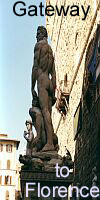
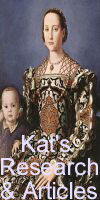
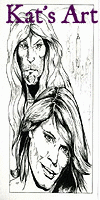
|
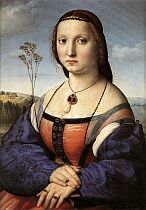 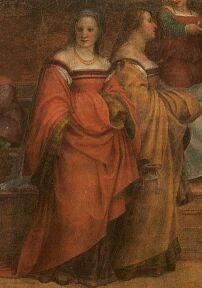
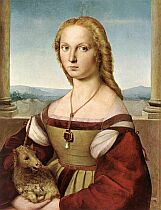 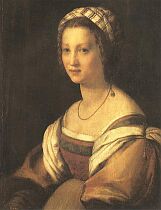
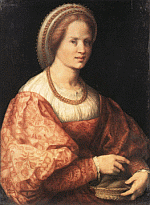 |
1510's
-
Imbusto: the imbusto (bodice)
of
women's dress had a less rigid shape, initailly rounded but tight
-
shoulders wide, angular
-
waist: high
-
Sleeves: large, one piece, progressing to 1530's (2 part: top voluminous,
lower half tight), usually tied on to show camicia at shoulder. long,
covering part of hands til 1540s (
- exceptions: seen in figures 4 (transitional - two part, same
colour, but tied on) and 5 two part same colour apparently sewn or
laced on.)
-
Faldia: appears to be mainly pleated
- girdle: none or no hanging extension.
-
camicia: becoming high necked in some instances (usually no collar)
-
convercie (like hanky) over shoulders, usally outside of dress.
Portraits:
- Raffaello's Portrait of Maddalena Doni, 1506
- Andrea del Sarto The Birth of the Virgin
-
Raphael's Lady with a Unicorn
-
Andrea del Sarto PortraitArtist's Wife 1513-1514 -transitional sleeve
- Pontormo's Lady with a basket of spindles 1516 -exception: is a very early example of the large top sleeve but not common.
|
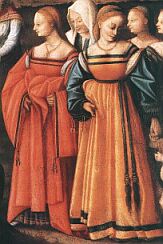 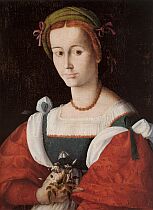
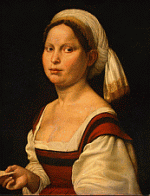 |
1520's:
-
Imbusto: shoulders slightly squarer, still wide. neckline starts to become lower.
-
Waist: straight, still high but slowly lowering up to the 1540's
-
Sleeves: transitional from large one -piece to two piece, with gathered
or puffed top (baragoni) - less evidence of the hints of 1530s???. covering part of hands til 1540s
-
Faldia: mostly pleated , garding seen at hem
- girdle: none or material
-
camicia: square lower necked camicia still popular, others creeping higher to 1540's, no partlets often
Portraits:
-
Bacchiacca's The preaching of john the baptist. 1520
-
Bacchiacca's Lady with a Nosegay, 1520's
-
Giuliano Bugiardini's Portrait of a Young Woman, 1525.
|
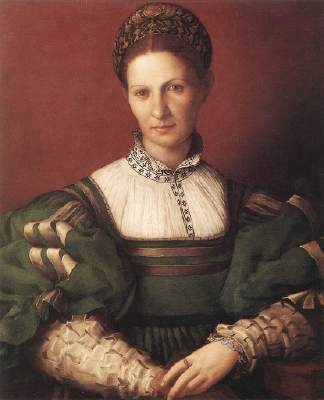 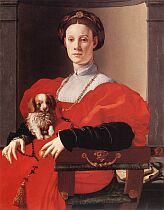
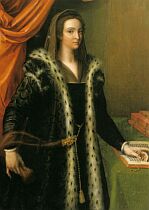 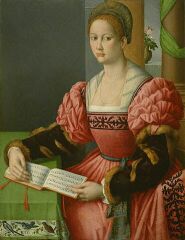 |
1530's:
- Imbusto:tight and flatter but not yet cylindrical. garding becoming more decorative.
-
Waist: straight, slowly lowering,
-
sleeves: top puffy, large, gathered baragoni -supported by bombast . early 1530's the top is low to
elbow, starting to become higher and commonly rouched, by end of
decade. Does not appear to be tied with ribbons to shoulder (possibly
hidden lacings) lower sleeve often slashed. could be of contrasting
materials.
-
skirt: signs of cartridge pleating being more common
-
girdle: usually mateial, could be no hanging extension, extensions beoming more popular. (exception - Fig 3 - pearl extended girdle more constistent with later decades)
-
camicia: could be high necked with collar, often embroidered
-blackwork, white work -(no lace). could be square necked with
convercie being tucked in more often now.
Portraits:
-
Agnolo Bronzino: A Daughter of Matteo Sofferoni, 1530-1532
-
Bronzino: Portrait of a Lady 1533
-
Cristofano dell Altissimo: Guilia Gonzaga 1535 - (exeption at this time, smaller cap sleeve with a loose gown, similar to that worn in 1540-50s onward by eleanora.)
-
Bacchiacca Portrait of Woman with a Book of Music, 1540
|
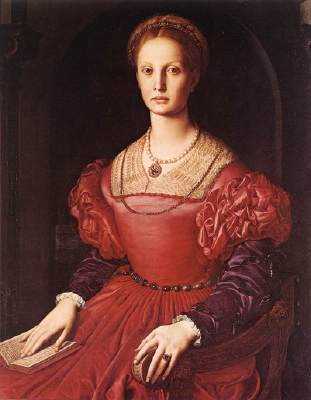 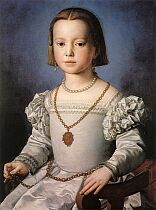
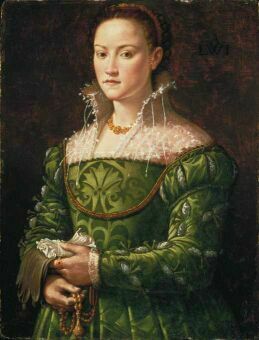 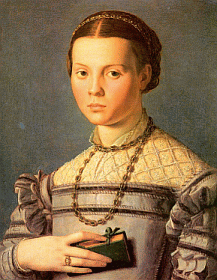 |
1540s:
-
Imbusto: flatter in shape over the bust -becoming barrel shaped and
rigid, higher neckline, square neck with very wide, longer and stiffer shoulders (narrow
straps). garding could match sleeve decoration
-
Waist: much lower - below natural waistline
-
sleeves: narrower on the hole, ribbons or buttons to attatch to should
more common again. usually top (baragoni -supported by bombast) and botton same colour/material. could
be made in panes, slashed, buttoned etc. the upper part/puff gradually
became smaller (easier to wear the zimarra - turkish style loose
overgown - which was popular with Eleanora)
-
skirt: starting cartridge pleated, as last decade with preferences towards being pleated by end
-
girdle: could be metallic or beaded, could be extended or not.
-
camicia: lower necked camicia (high neck was definately out of
fashion by now), blackwork, white work, cutwork, goldwork and
embroidery seen
-
Partlets originally collarless usually had collars by end of decade
which became taller. partlet could be richly decorated. elaboarted
folding and creasing seen.
Portraits:
- Portrait of Lucrezia Panciatichi 1540
- Bronzino: Bia, The Illegitimate Daughter of Cosimo I de' Medici c. 1542
-
Bronzino unknown Florentine Woman. 1544-45
- Bronzino Portrait of Girl with a Book. 1545
|
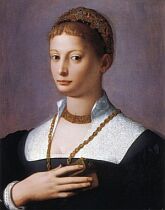 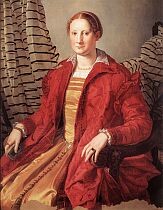
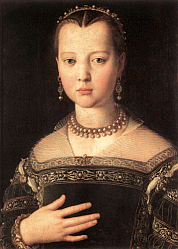 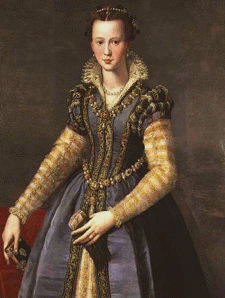
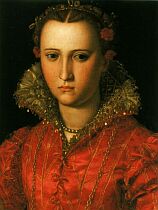 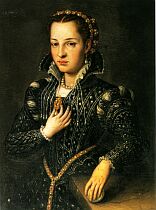 |
1550's:
common outfit: gown, jerkin (worn open at top, unlike the Spanish fashion), zimarra (1556) co-ordinated with gown.
-
Imbusto: progressing from 1540's, becoming tighter and closer fit. the
lower neckline continued, could be hidden by high neck of the overgown
or jerkin or loose gown.
-
Waist: returned to natural waist and, by the mid 1500's, the waistline had a peaked front being seen in 1550's,(in the French
fashion).
- sleeves: petticoat (underdress) narrow with gradually
decreasing size
of baragoni (puff top), esp on petticoats. - which is decorated wtih
embroidery, braid and trim,
commonly buttoned to shoulder. spiral pattern becomes more popular
through to 1590s (but can be seen starting here). double puff,
esp on jerkins the sleeve material usually is
the same as the dress itself. Commonly an overgown, jerkin or
loose gown was worn. This
had a short sleeve with a 'camicia-filled' puff or puffs and band. It
was commonly sectioned/paned with decoration. The baragoni becomes
smaller to almost a shoulder roll only by the 1570s.
- faldia: mainly pleated, gathered more at back, pleats, front flatter to show off
embroidered gards on front. Could be front split, especially on overgown.
-
camicia: low square necked embroidered - colourful, pearls, spangles,
gold, gathering. embroidery more elaborate, could be plain with lace
edging..
- partlets: with collars with ruffs on edge of collar,
decorated.- similar
to those of Spanish fashion from 1550s.(though usually worn open,
unlike Spanish fashion).- ring ruffles were not common until late
1560's and 1570s.
Portraits:
- Bronzino: Portrait of a Young Woman, 1550-05
- Bronzino: Portrait of Lucrezia Panciatichi,1550. (recently attrib as possibly
Eleanora, (because of girdle) - this is a typical Eleanora outfit.
-
Bronzino:: Maria d'Cosimo, 1551
- Allori: Maria d'Cosimo, 1555-1557
-
Florentine school: Lucrezia di Cosimo I, 1555 60 (spanish style part)
- School of Bronzino: Lucrezia de medici, 1558
|
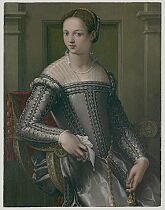 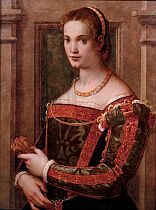 |
1560's
-
imbusto: stiff, possible use of corsetry in 2nd half (until then was padded with felt, carboard stiffening etc)
-
waist, low and peaked.
-
sleeves, double puffs were more elaborate, could have scalloped borders
(seen in 1558 above), becoming very small puffs on jerkins and zimarra, being
almost verticle.
- trim is on sleeves, neckline, sides of imbusto and centre skirt. Could be centre imbusto also.
Portraits:
-
Zucci, Met museum Portrait of Woman, 1560-65
- Tossini Portrait of Lady half length in green silk dress with gold trim holding a glove (Christies Lot 0017) 1560's?
|
More Details on the Fashions of Sleeves in Florence to 1550
Glossary:
imbusto: bodice
baragoni: top sleeves
camicia: chemise
faldia: skirts
convercie: shoulder cape/hankerchief
gorgiere (e colletti) : partlets
saia - gown
Bibliography:
- Alcega, Juan.The Tailor's Pattern Book, 1589 Facimile, Ruth Bean, Carlton,
Bedford, 1979.
- Arnold, Janet Patterns of Fashion, MacMillan, London, 1985. ISBN: 0-333-38284-6
- Arnold Janet, Queen Elizabeth's Wardrobe Unlock'd, Maney, Leeds,
1988, ISBN:0-901286-20-6
- Kovesi Killerby, Catherine, Sumptuary Law in Italy 1200-1500, Oxford
University Press. NY. 2002. ISBN:0-19-924793-5
- Crowfoot E, Pritchard F & Staniland K, Textiles and Clothing
1150-1450, Boydell Press, Woodridge, 2001 (ed) ISBN: 0-85115-840-4
- Frick, Carole Collier. Dressing Renaissance Florence.: Families Fortunes
& Clothing. John Hopkins University Press. Baltimore. 2002. ISBN:
0-8018-6939-0
- Orsi Landini, Roberta & Niccoli, Bruna. La Moda a Fioenze 1540-1580.
Pagliai Polistampa, Firenze, 2005. ISBN: 88-8304-867-9
- Ricci, Elisa. Old Italian Lace Volume 1. William Heinemann, London.
1913 available on line at: http://www.cs.arizona.edu/patterns/weaving/books.html
- Veccellio, Cesare. Vecellio's renaissance Costume Book. Dover
Publications. NY. 1977. ISBN: 0 48623441X
Web
Sites:
- Medici Archive Project: www.medici.org/ (1/06)
- Metopolitan Museum of New York. http://www.metmuseum.org/
- V&A Museum website: http://images.vam.ac.uk (May, 2004)
- Web Gallery: Medici portraits by Bronzino. http://www.kfki.hu/~/arthp/html/b/bronzino/1/index.html
- Festive Attyre: http://www.festiveattyre.com/research/secondflor/portfolio.html
|
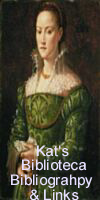
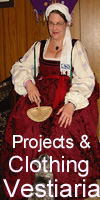
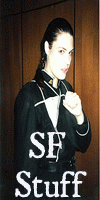
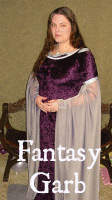
|






























